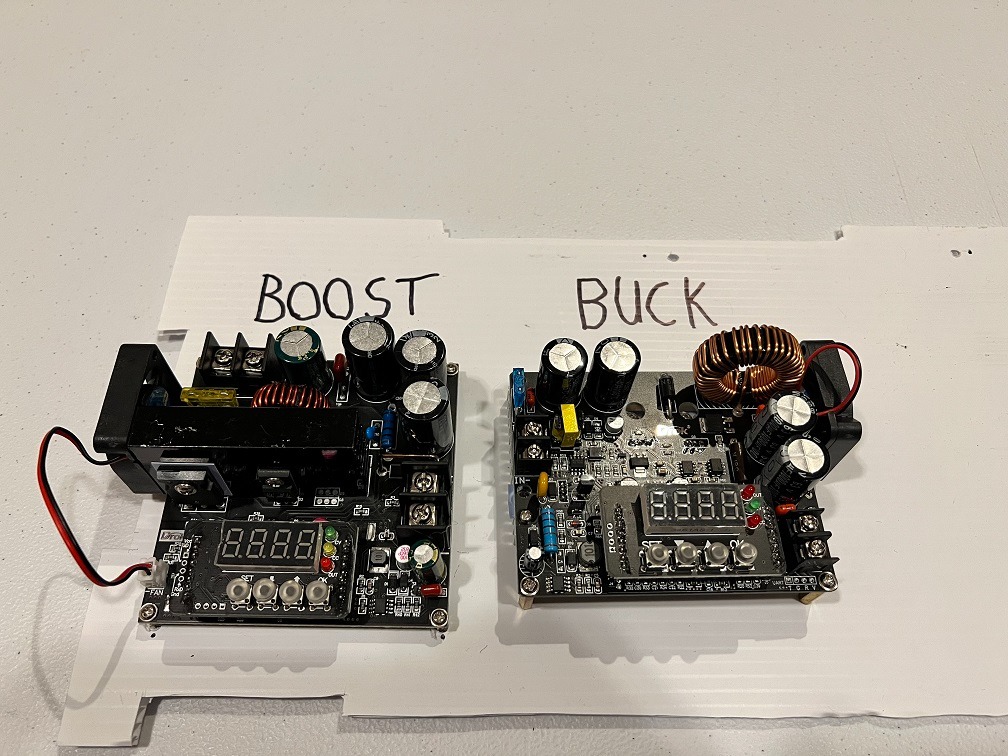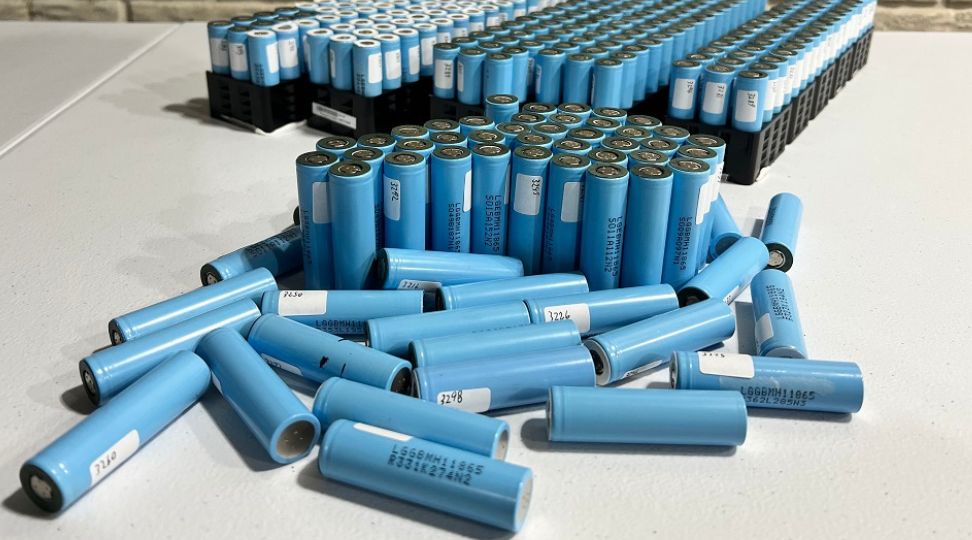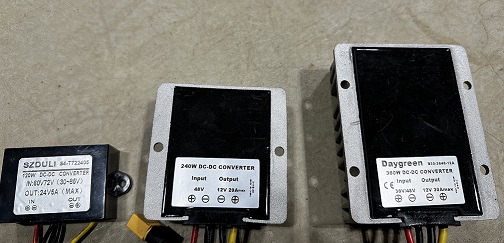
Buck Converter Or Boost Converter Which Is Best
Table of Contents
- How Do Buck Converters Work
- When Should You Use a Buck Converter?
- How Do Boost Converters Work
- Does A Boost Converter Increase Power?
- Buck Converter Or Boost Converter Which Is Best For Efficiency?
- How Can DC to DC Converts Be Used With Lithium Ion Batteries?
- So, Buck Converter Or Boost Converter Which Is Best?
Buck converter or boost converter, which is best? When you have to change one voltage to another, this question can come to mind. Many of the devices that we rely on every day have some sort of boost or buck converter circuit built into them. This makes sense if you think about it. Things like hard drives, mp3 players, video recorders, laptops, and many other devices require voltages that are outside of the natural range of a lithium-ion battery pack, yet run on battery power commonly.
Buck and boost converters are both DC-to-DC converters that rely on switch mode power supply technology. Buck and boost converters allow lithium-ion batteries (or any other power source) to operate beyond their normal voltage range. They can also be used to charge lithium-ion batteries.
Boost and buck converters perform the same opposing function in that they allow the user to change from one voltage level to another to achieve a higher level of compatibility between power supplies and the devices being powered. When it comes to a buck converter or boost converter, which is best, it really comes down to the specific application.
If you need to have a voltage that is lower than what you are starting with, then you are going to need a buck converter. If, on the other hand, you need a higher voltage than what your batteries can provide, then a boost converter is your only option.
Buck converters are generally more efficient and more flexible than boost converters. They also require fewer components compared to boost converters. There are devices that combine buck and boost converters and they are called - you guessed it - buck-boost converters. A buck-boost converter does exactly what it sounds like. It switches between buck and boost modes depending on how low (or high) the input voltage is compared to the target output voltage.
How Do Buck Converters Work
Buck converters, also known as step-down converters, use one or more transistors as a switch. This switch rapidly connects and disconnects the input voltage to an inductor. Inductors have many properties, one of which is the resistance to an instantaneous change in current.
A buck converter can be thought of as a device that connects just enough of the input to the output to achieve a lower voltage. Energy is conserved, however, in the form of a higher current. So if you have an ideal, totally lossless buck converter that you put 12V and draw 4 amps from it, you are only going to be drawing 2 amps from the input.
Buck Converter
- Steps down a voltage from a higher input to a lower output.
- Current is increased on the output in order to lower the voltage.
[[ aff type=aff ~ link=https://amzn.to/3E3qLOz ~ title=`Buck Converter DC to DC Step Down` ~ image=https://admin.cellsaviors.com/storage/81L1-6rB9OL._AC_SX679_.jpg ~ description=`The input voltage range is DC 10-65V; Output voltage range is DC 0-60V, which is adjustable and used to convert 24v to 12v 5v; Output current range is 0-12A, which is adjustable; Max output power is 720W` ~ height=large ~ buttonText=Check Price`` ]]
When Should You Use a Buck Converter?
A buck converter should be used when a device’s maximum input voltage is lower than the source voltage. If your power supply, battery, or other voltage source is higher than what the device can run at, then you will need a buck converter.
How Do Boost Converters Work
Boost converters, also known as step-up converters, also rely on the fact that an inductor prevents the instantaneous change of current. The setup is a bit different, though. In a boost converter, the rapidly connecting and disconnecting switch is used to 'charge' an inductor that is effectively put in series with the rest of the circuit. Because the inductor is able to store and re-emit current, it can do so during the on-and-off stages of the switch mechanism. This energy is sent through a diode (a one-way valve for electricity) and into a capacitor where it is stored at a higher voltage than the input.
Boost Converter
- Steps up a voltage from a lower input to a higher output.
- Current is decreased on the output in order to raise the voltage.
While it's true that a boost converter can work at single-cell lithium-ion voltages, that is a less-than-ideal situation.
Remember, there is no such thing as a free lunch. So, if you want to increase the voltage on the output, you have to increase the current on the input. If you double the output voltage, then you must double the input current. Lithium-ion cells can most certainly handle such current requirements, but the components used to make boost converters have a harder time doing so.
This is why low voltage boost converters are physically small devices that support a tiny amount of current on the order of just 1 or 2 amps or so. Things have come a long way, however, and low voltage boost converters are becoming more and more common. There are plenty of USB charging boards on the market now that can take an input voltage of 3 to 4 volts and output 5, 9, or even 12 volts at 1.5 amps.
[[ aff type=aff ~ link=https://amzn.to/3y4sDDc ~ title=`Boost Converter` ~ image=https://admin.cellsaviors.com/storage/81c4URq5jjL._AC_SX679_.jpg ~ description=`Input voltage: DC 8-60V; Output voltage: DC 10-120V; Input current: 0-15A; Output current: 0-15A.` ~ height=large ~ buttonText=Check Price`` ]]
Does A Boost Converter Increase Power?
Yes. A boost converter can increase the voltage of a power supply, which allows it to deliver more power. For example, if you have a voltage source of 12 volts and a resistive load of 2 ohms, the current will be 6 amps. 6 amps times 12 volts is 72 watts of power. If you boost the 12 volts to 24 volts and connect it to a 2 ohm load, 12 amps of current will be drawn. 12 times 24 is 288 watts of power.
In contrast, if you have an active load that is current-limited, it works like this: 12 volts times 20 amps (the active load limit) is 240 watts. If you boost the 12 volts to 24 volts, you will still have the current limit of 20 amps, which will net you 480 watts.
Buck Converter Or Boost Converter Which Is Best For Efficiency?
Generally speaking, boost converters are less efficient than buck converters, therefore in our experience buck converters are better in that regard. At first glance, this may seem like it's because boost converters increase voltage while buck converters decrease voltage. That, however, is not the reason why.
The reason why a boost converter is generally less efficient than a buck converter boils down to how the devices differ in operation. Because the devices work in different ways, they need slightly different components in different arrangements. It just so happens that boost converters use a little more energy to do their job than buck converters. The good news is that the difference is quite small.
For both boost and buck converters, expect about 90 to 95 percent efficiency depending on load current and difference between input voltage and output voltage. And remember, while it's true that the difference between input and output voltages in DC to DC converters is not directly proportional to its efficiency level, it’s certainly a key factor.
So, when choosing a boost or buck converter for your application, make sure to set things up so that the difference between input and output voltage is as small as possible.
How Can DC to DC Converts Be Used With Lithium Ion Batteries?
Buck converters and boost converters can be used with lithium-ion batteries in several ways. You can use a buck converter to lower the voltage of a battery so that the battery can operate devices that are normally outside its range. As you would expect, a boost converter can be used to increase the voltage of a battery so that it can operate higher-voltage devices.
These same regulator boards can be used to charge batteries as well. It is important to note, however, that to be able to use a boost converter or a buck converter as a lithium-ion battery charger, you must ensure that it is a DC-to-DC converter of the constant current variety. You can look to see if the buck or boost converters offer CC/CV, constant current, and constant voltage. If they do, you can use them to charge lithium batteries and even build a bench power supply.
So, Buck Converter Or Boost Converter Which Is Best?
Well, that depends on your application. If you are using a converter board as a battery charger and you have a 4S battery (16.8V charge voltage) and a 24V power supply, then you will need a constant current buck converter as you would need to lower the voltage going into the battery.
In contrast, if you are using a 12V supply to charge that same battery, then you would need to use a constant current boost converter to step up the charge voltage from the lower voltage DC supply.
When using a DC-to-DC converter to regulate the voltage of a battery to operate a device, it's pretty much the same situation. The main difference is that if you are using a boost or buck converter to control the discharge voltage of a battery, you will not have to use a constant current converter; a simple constant voltage module will work just fine.
Can You Use a Buck Converter as a Boost Converter? No, you cannot use a buck converter as a boost converter.
Conclusion
Ideally, you would want a battery and a load that does not require a buck or boost converter in between. There are times, however, when this is either not an option and there are even situations in which putting a converter between the battery and load can actually extend the operational capacity of the battery pack.
If you are looking through all the parts on Amazon and thinking to yourself, ‘Buck converter or boost converter, which is best?’, the answer is neither. It really depends on your application and your specific needs. In fact, boost converters and buck converters have pretty much opposite roles. So if you need to use a boost converter to make something work, no buck converter will be a viable solution and vice versa.
We hope this article helped you determine whether a buck converter or boost converter is best for you. Thanks for reading!


